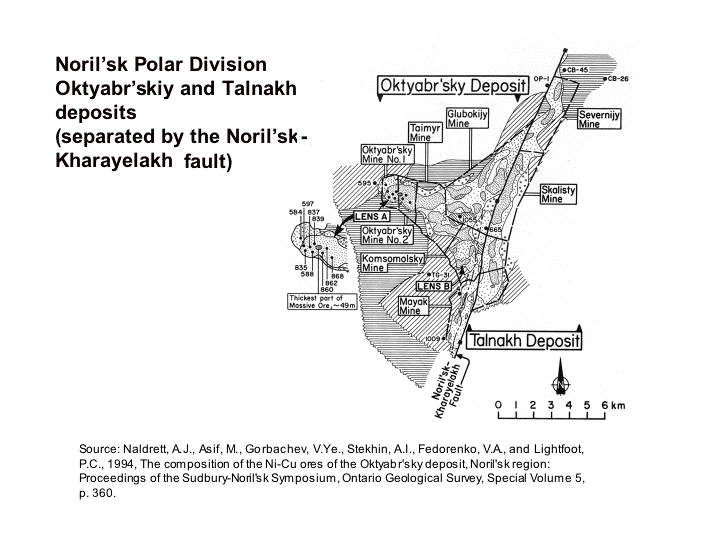
U.S. Geological Survey Open-File Report 03-059
Version 1.0
Presented at the Platinum-Group Metals Seminar 2002
New York, NY
September 18, 2002
Sponsored by CPM Group and
the International Precious Metals Institute
Richard Levine and David Wilburn
U.S. Geological Survey
Notes:
Good afternoon. I want to thank the CPM Group for inviting me and my colleague David Wilburn from the Denver office of the USGS to delay your lunch with a report on our research on Russian PGM production and resources. The information we are presenting was derived primarily from information published in Russia by officials from Noril'sk in journal articles and from the Noril'sk Annual Report 2001. Although a considerable amount of information has been published in Russia on the topic of Russian PGM production and resources, as you are all probably aware, data on Russian PGM reserves and production are regarded as secret. Therefore, we are not reporting actual reported Russian production or resource numbers, but our estimates. If anybody has information that we could use to correct or improve our analysis, we would greatly appreciate the opportunity to make such improvements.
If you are familiar with an article I published with Andrew Bond on this subject in 2001 in Post-Soviet Geography and Economics, Dave and I have carried this research further and in greater detail by expanding our projected PGM production series to the year 2010 and doing an analysis of Russian PGM resources. Our analysis concentrates on PGM production at Noril'sk Nickel's Polar Division mines in East Siberia where all of the company's PGM are mined and more than 90% of Russia's PGM mining occurs. PGM are not produced from nickeliferous ores mined by Noril'sk on the Kola Peninsula. Noril'sk is the world's largest nickel mining and metallurgical company, and produces copper, cobalt, gold, silver, and other ore constituents.

Notes:
We have heard reports that as much as 10 t/yr of PGM (mostly platinum) are mined from placer deposits in the Urals, Siberia, and the Russian Far East. Because we lack data to analyze the topic of placer mining, we are assuming for the purpose of our analysis that 10 t/yr of PGM is now being mined from placers and that this level of production would remain constant in the future. Also, we are only going to discuss Russia's PGM production and not deal with PGM in stockpiles, for which we lack data and have not tried to research. We also will not discuss recycling, an increasingly important factor in the world's PGM supply for countries who are major consumers of PGM (Russia is currently not one).
Noril'sk's future lies as a PGM producer. In effect, Noril'sk Nikel has become Noril'sk PGM. As of 2001, 51% of Noril'sk's revenues came from PGM. Noril'sk's current development strategy is oriented towards maximizing PGM production rather than nickel. As you will see in our analysis, Noril'sk's remaining resources are richer in PGM relative to nickel and copper than ores that were previously mined and are now being mined. Mining is depleting the region's nickel-rich ores, but it still contains large resources with a high PGM content. My colleague Dave Wilburn will discuss the resource base at Noril'sk as its relates to current and future PGM production. We will focus on the three types of ores that comprise Noril'sk's resource base, nickel-rich ores, cuprous or copper rich ores, and disseminated ores, and how the quantities of these three types of resources will affect Noril'sk as a future PGM producer. We will also discuss the processing of tailings at Noril'sk to recover PGM and the potential of Russian PGM production from other deposits in the Noril'sk region and in other parts of the country. And now Dave will proceed.
Current Status
Notes:
Thank you, Richard. Ladies and gentlemen, it is my pleasure to be here today to share some of the highlights of one component of USGS work on Russian PGM deposits. As Richard has indicated, the Noril'sk region has changed dramatically in recent years. Focus has shifted from base metal production to PGM production. In 2001, more than one-half of the region's revenue was derived from PGM, and all indications suggest that the significance of PGM from the region will increase. Investment is being shifted to improve PGM production in the region. Cuprous and disseminated ores, with lower base metal grades but comparable PGM grades to nickel-rich ores, are increasingly being mined to compensate for depletion of nickel-rich ores. Beneficiation facilities are being upgraded to improve PGM recovery from disseminated ores and tailings.
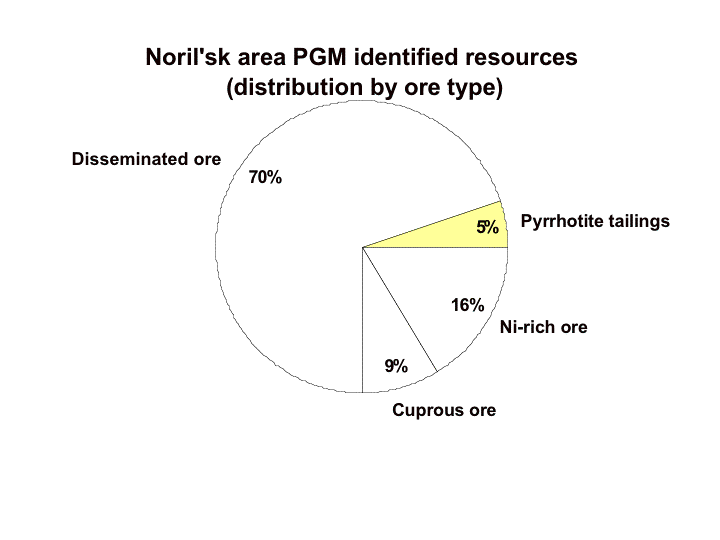
Notes:
As Richard has alluded, data on PGM are limited because Russian law prevents disclosure. Consequently, our resource estimates were not based on actual drilling information, but rather on reported percentage distribution of the different types of ores in each deposit, the grades of these ores, and mine life data. The level of reliability can most closely be associated with the identified resource level of classification used by the USGS. Most of the district's base metal production since WWII came from the mining of nickel-rich ores, generally from pockets with highgrade nickel or copper. While PGM grades may have been significant, PGM were treated as a byproduct of base metal production. By 2000, however, nickel-rich ores constituted only 16% of the district's resources. The bulk of the district's PGM resource (70%) came from disseminated ore, containing widely dispersed base and platinum-group metal values requiring different beneficiation processes from nickel-rich and cuprous ores. Cuprous ores constituted about 9 percent of PGM resources in 2000. Stockpiled pyrrhotite tailings from previous nickel/copper production represent about 5 percent of total resources.
Characteristics of PGM-bearing ores
Ni-rich
Cuprous
Disseminated
Low-sulfide disseminated
Pyrrhotite tailings
Sources: Bond & Levine (2001); Krivtsov et al. (2002)
Notes:
Briefly, let's compare the characteristics of these various ore types. This will be helpful in assessing future directions for the Russian PGM industry. Nickel contents of cuprous and disseminated ores are much lower than those of nickel-rich ores. Copper contents of cuprous ores are slightly lower than in nickel-rich ores; but are much lower in disseminated ores. Unlike base metal contents, PGM contents remain relatively high for all ore types. While PGM content of disseminated ore can range from 3-9 g/t, the PGM contents of lowsulfide disseminated ores are quite comparable with the PGM contents of nickel-rich or cuprous ores. PGM content in tailings are still quite high, at 8 g/t. Note that cuprous ores have generally higher palladium:platinum (Pd:Pt) ratios than other ores. The Pd:Pt ratios in the other ores are somewhat variable, but the dominance of palladium to platinum is constant. Unlike base metal values, PGM values remain strong, regardless of ore types. Please note that if the ore is selectively mined, ore feed grades can be significantly higher.
Noril'sk area PGM identified resources in 2000
Disseminated ore 270.2 Moz (8.4 million kg)
Ni-rich ore Moz (2 million kg)
Cuprous ore 47 Moz (1.5 million kg)
Pyrrhotite tailings 19.3 Moz (600 thousand kg)
Notes:
No tonnages for the district by ore type are reported by Russian sources. USGS estimates for resource data were derived from a mine-by-mine analysis, looking in part at reported mine specific data on relative distribution of various ore types. USGS-derived estimates for the Noril'sk district resources, expressed in terms of percentage of each ore type, agree closely with corresponding published Russian data.
| Source | Resource estimate (Moz PGM) | Ore types1 | Estimation method | Data sources |
|---|---|---|---|---|
| Oktyabr'skiy | 119 | R (17.7%) C (24.6%) D (57.7%) |
Calculation from ore distribution and known production data. | Piven' et al. (1999) Bond & Levine (2001) |
| Taymyrskiy | 58 | R (20.9%) C (2.4%) D (76.7%) |
Calculation from ore distribution and known production data. | Piven' et al. (1999) Bond & Levine (2001) |
| Komsomol'skiy | 135 | R (0.7%) C (10.7%) D (88.5%) |
Calculation from ore distribution and known production data. | Piven' et al. (1999) Bond & Levine (2001) |
| Mayak | 21 | R (1.9%) C (1%) D (97.1%) |
Calculation from ore distribution and known production data. | Piven' et al. (1999) Bond & Levine (2001) |
| Skalistyy2 | 12 | R (100%) | Estimated from reported resource total of Skalistyy and Glubokiy. | Piven' et al. (1996) |
| Glubokiy2 | 12 | R (100%) | Estimated from reported resource total of Skalistyy and Glubokiy. | Piven' et al. (1996) |
| Zapolyarnyy | 19 | D (100%) | Based on estimated mine life and production data. | Bond & Levine (2001) |
| Medvezhiy Ruchey | 5.2 | D (100%) | Based on estimated mine life and production data. | Bond & Levine (2001) |
| Pyrrhotite tailings | 19.3 | NA | Reported data | Interfax MMR (2001b) |
| Placer mining | 9.6 | NA | Based on estimated mine life and production data. | Interfax MMR (1997) Interfax MMR (1998) |
| Kursk Magnetic Anomaly | 6.4 | NA | Reported data | Kushnerenko et al. (2002) |
| Pana deposit | 33.4 | NA | Reported data | Interfax MMR (2001a) |
| Total | 450 | -- | -- | -- |
NA Not available
1R -- Ni-rich ore; C -- cuprous ore; D -- disseminated ore.
2Does not include estimates of cuprous and disseminated resources.
Notes:
Details of the PGM resource analysis are shown here. Mine-by-mine estimates were derived from published data from Russian sources. Because legal restrictions limit the publication of PGM reserve and production data, estimates in general were derived either from known ore distribution and past reported production data on total gross weight of ore mined, or reported mine life data. Data sources are also shown in this table and referenced in the final slide of this presentation.
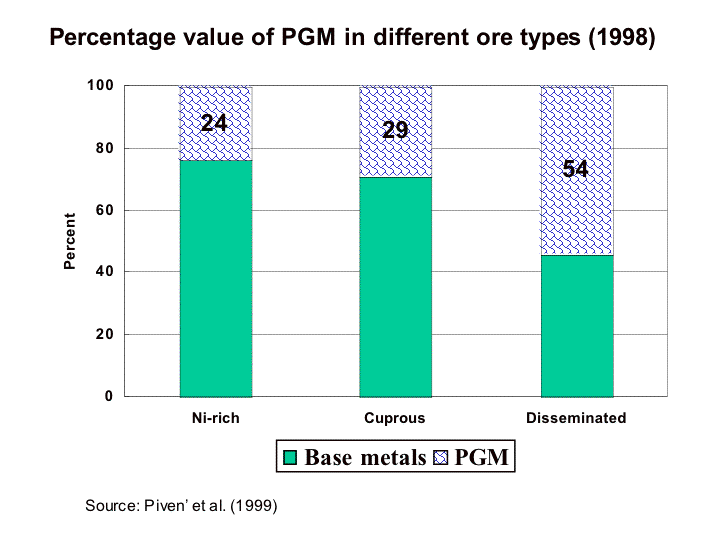
Notes:
As the district shifts from exclusively producing nickel-rich ores to producing other ore types, the percentage of value attributed to PGM increases. Based on reported 1998 prices by Noril'sk Nickel, PGM make up only 1/4 of the total value of nickel-rich ores. However, more than one half of the total value from a typical disseminated ore is derived from PGM. At today's prices, the percentage values would be even higher.
PGM prices in dollars per troy ounce
Anticipated development plans to 2010
Notes:
Short-term PGM development plans are based on Noril'sk Nickel's reported Development Plan to 2010, and supported by information reported from both Russian and western sources. More favorable PGM markets combined with reduced nickel content of remaining ores have shifted emphasis from base metals to platinum group metal recovery. Noril'sk Nickel began to emphasize the Taymyr Peninsula's PGM capacity about 1998. As nickel-rich reserves from the company's older mines are being depleted, the company is developing its abundant resources of cuprous and disseminated ores, with a comparably high PGM content. The plan envisions opening 2 new mines during this decade (2000- 2010). The Skalistyy mine, originally scheduled to reach full production in 2001, appears to be scheduled to achieve full production by 2005. The Glubokiy mine may come into production by 2010. There is also the possibility of opening a new mine in the northern part of the Talnakh deposit after 2015. In addition, mining at the Oktyabr'skiy mine would shift from nickel-rich ores to cuprous ores, with 1/4 of the Ni content, but 90% of the PGM content. Increased production of disseminated ores at other Polar Division mines is planned. Production at the two oldest mines (Zapolyarnyy and Medvezhiy Ruchey) is to expand into the recovery of low-sulfide disseminated ore, containing a much higher PGM content than currently mined ore. Meanwhile, the company continues to develop capability to recover PGM from abundant pyrrhotite tailings from many years of nickel/copper mining.
| Mine | Ore type | 2000 production (thousand oz PGM) |
2010 production (thousand oz PGM) |
|---|---|---|---|
| Oktyabr'skiy | Ni-rich | 1,472 | 1,180 |
| Cuprous | 85 | 473 | |
| Disseminated | 6 | 86 | |
| Total | 1,563 | 1,739 | |
| Taymyrskiy | Ni-rich | 941 | 1,041 |
| Komsomol'skiy | Ni-rich | 176 | 33 |
| Cuprous | 315 | 95 | |
| Disseminated | 29 | 289 | |
| Total | 520 | 417 | |
| Mayak | Ni-rich | 139 | 0 |
| Disseminated | 0 | 116 | |
| Skalistyy | Ni-rich | 61 | 695 |
| Glubokiy | Ni-rich | 0 | 69 |
| Zapolyarnyy | Disseminated | 195 | 717 |
| Medvezhiy Ruchey | Disseminated | 112 | 287 |
| Pyrrhotite tailings | Mixed | 14 | 309 |
| Polar Division | Total | 3545 | 5391 |
| Ni-rich | 2789 | 3018 | |
| Cuprous | 400 | 569 | |
| Disseminated | 342 | 1495 | |
| Tailings | 14 | 309 |
Notes:
Production estimates were also derived from mine by mine analysis based upon known information about ore grades and distribution. This slide is shown to convey information of the level of detail available in this study, and to invite you to anticipate the final study report which is being prepared. Production changes were estimated on an annual basis, based upon reported data from the 2001 Noril'sk annual report, other published information (from both western and Russian sources), and the authors' knowledge of the district. Data reported here relates to Noril'sk area mines only. Data in this figure do not include placer production, estimated at 10 t/yr. Figures do not include material from PGM stockpiles, so 2000 values estimated here may differ from other published Russian supply estimates. The 2010 production estimates incorporate Russian planned production. No attempt was made to reconcile plans with available capital for investment or changing market conditions.
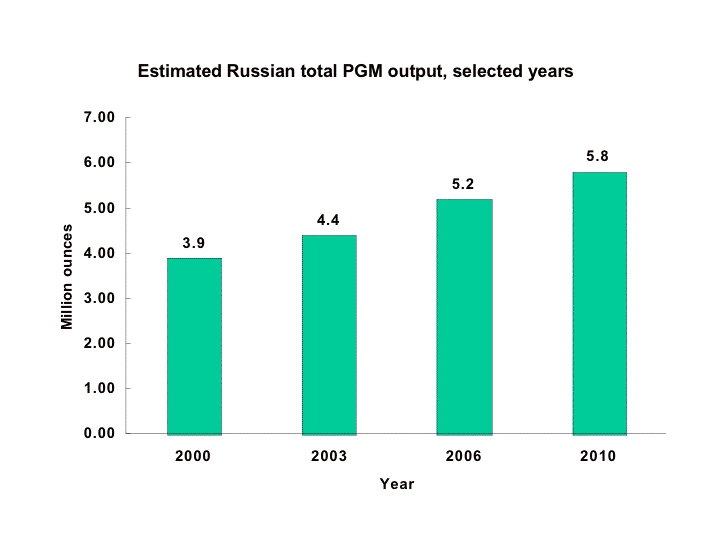
Notes:
Based upon available data, production estimates for each year of the period 2000-2010 were made. Data for 4 representative years are shown here. PGM production from Russian placers has been included, assuming the current rate of 10 t/yr of PGM throughout the period. It is apparent that total PGM production is expected to increase during this period. By 2010, approximately 5.8 Moz of total PGM would be produced, based upon the parameters considered in this study.
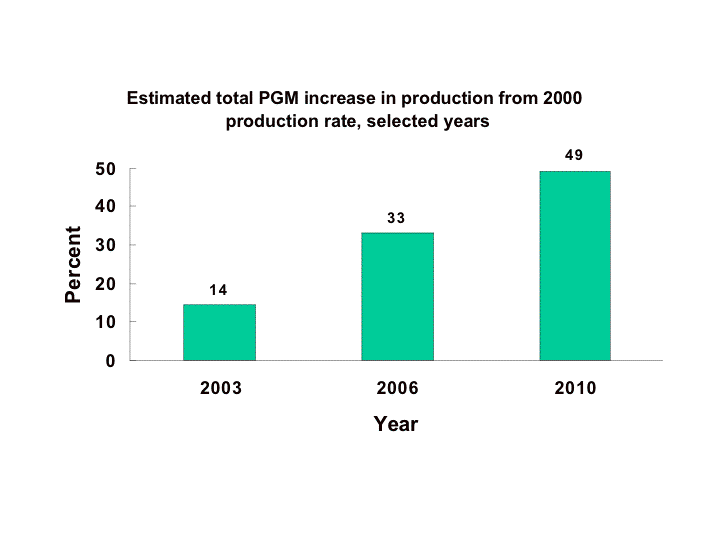
Notes:
Total PGM production is estimated to increase 14% from the 2000 level by 2003. Total PGM production is estimated to increase by 33% from the 2000 level by 2006. Total PGM production is estimated to increase almost 49% from the 2000 level by 2010.
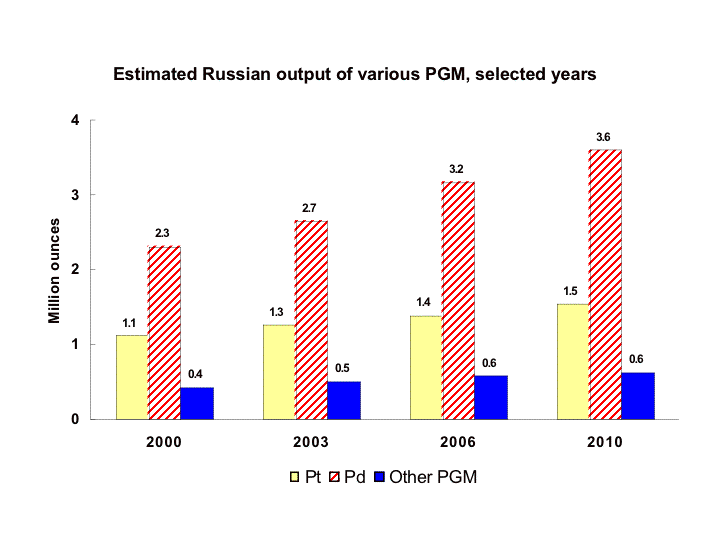
Notes:
In terms of individual platinum group metals, the data suggest that Pd production would increase from 2.3 Moz to 3.6 Moz by 2010. Pt production is estimated to increase from 1.1 Moz to 1.5 Moz by 2010. Production of other PGM would rise from about 400 koz to 600 koz by 2010.
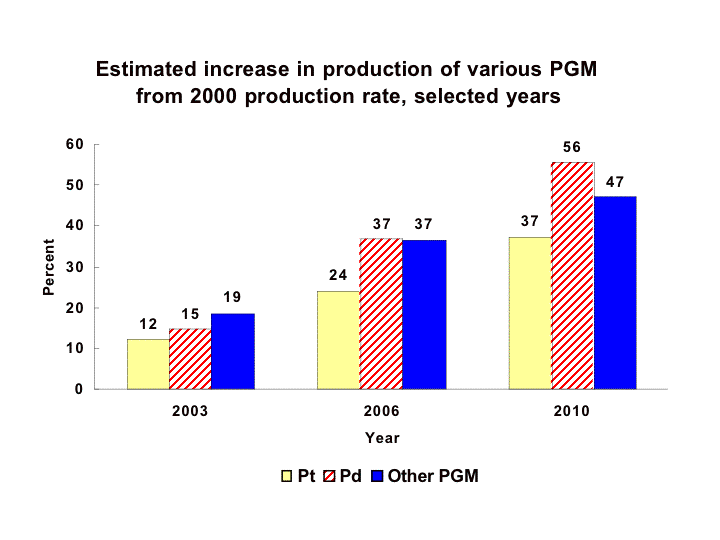
Notes:
In terms of change from the 2000 level, palladium production would grow by about 56% during the period 2000-2010. Platinum production is projected to grow 37% during this period. Production of other PGM is projected to grow about 47% during this period.
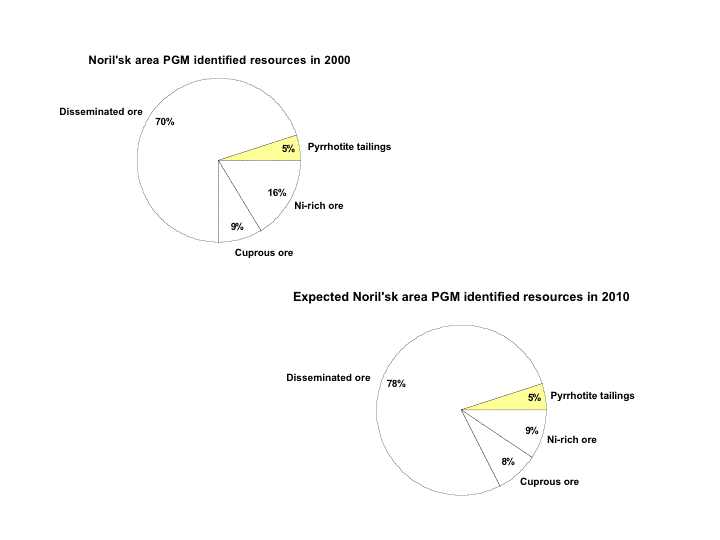
Notes:
Assuming the production levels estimated in this study, the sources of production of Noril'sk area PGM resources would change between 2000- 2010 as indicated in this diagram. By 2010, nickel-rich ore would decrease from about 16% of the total identified resources to about 9% of the total identified resources. By 2010, disseminated ore (including low-sulfide disseminated ore) would increase from 70% of the total ore to about 78% of the total available ore. No attempt was made to include new resources from additional sources (except nickel-rich ores from Skalistyy and Glubokiy). The changes in distribution reflect changing conditions at existing mines only.
2010 and Beyond
At projected 2010 production rates (assume Glubokiy at full production), Noril'sk area mine lives after 2010 are estimated as:
Other delineated Russian PGM sources:
Resources from other areas (unquantified)
Notes:
Based upon these projections, nickel-rich ore is adequate to maintain the 2010 rate of total PGM production until 2020. PGM production from disseminated ore could be maintained well beyond 100 years. These assumptions are based on maintaining estimated 2010 PGM production rates, except for the additional increase in production that would come from the new Glubokiy mine. Estimates are for resources currently planned for development at Noril'sk, and do not include placer mine production or development of other Russian PGM resources. Nor do we include economic or technical factors or changing market conditions in our computations. Even if 1/3 of the disseminated ore was not able to be mined for economic or technical reasons, the district would be able to support PGM production at proposed rates for more than 100 years.
By mining a mixture of the different ore types and opening new mines, Noril'sk can extend the life of the various ore types (especially the nickelrich ore). By appropriate blending and sequencing the opening of new mines, appropriate ore grades could be maintained for a longer time than by sequentially mining high grade nickel-rich ore zones, then mining lower grade ore types.
Conclusions
Notes:
As you can see from our presentation, Noril'sk has large resources of PGM which may be economically exploitable. These PGM resources are sufficient for more than 100 years of production, even at a rate of output almost 50% greater than at present. Given today's prices, Noril'sk's future lies as a PGM producer. Its resource base is comprised of almost 80% disseminated ores with about as high a PGM content as the nickel-rich ores and cuprous ores currently being mined, but with a much lower nickel and copper content.
Our production projections are based on what could be possible if adequate investment and technology were available. We have not attempted to analyze the economic feasibility of mining these disseminated ores as such an analysis is dependent on numerous cost factors including the future prices of PGM and other co-hosted metals. Furthermore, it is not clear that Noril'sk has mastered the technology for expanding mining or processing disseminated ores at all mines currently recovering nickel-rich and cuprous ores and the technology for processing low-sulfide disseminated ores from the Noril'sk-1 deposit. We have assumed that, based on its development plans and previous experience in mining disseminated ores, Noril'sk will be able to master such technologies, although this has not been clearly demonstrated. Also, we have not dealt with the issue of Noril'sk obtaining investment funds for future mine development or expansion of processing facilities to process larger quantities of ores of different types. Thus, issues relating to future costs and the relative value of metals, new technologies, and acquiring adequate investment funds could all affect Noril'sk's future development prospects.
Conclusions
Notes:
We have limited discussion to Noril'sk deposits currently being mined, already under development, or planned for development. In addition, Russia has the potential to develop other identified and undiscovered resources at Noril'sk and in other regions of the country. One task that the USGS' Global Mineral Resource Assessment Project is undertaking is trying to determine undiscovered resources of PGM in the world, including Russia.
In conclusion, please keep in mind that we have used Russian-based information available to us to derive our best production and resource estimates, but we had no assessment capability of data we did not have access to, such as Russian PGM reserve, resource, or production data or precise data on the amount of exploration activity to derive our PGM resource estimates. Therefore our numbers, despite the rather exact way that they are presented, must be regarded as estimates with an unknown magnitude of error. However, we hope that we are approaching an answer as to the quantity of PGM potentially available from Russia, so that industry and Government can make better plans for developing and using PGMs in technologies vital to our environment and future energy supply. Thank you for your attention.
References Cited
Bond, A.R., and Levine, R.M., 2001, Noril'sk nickel and Russian platinum-group metals production: Post-Soviet Geography and Economics, no.2, p. 77-104.
Interfax Mining and Metals Report, 1997, Magadan artel beats 1996 alluvial platinum output target: Interfax Mining and Metals Report, v. 6, issue 1-2, January 4-10, p. 6,7.
-----1998a, Koryak producer to sell platinum to Noril'sk Nikel in 1998: Interfax Mining and Metals Report, v. 7, issue 42, October 9-16, p. 5.
-----1998b, Russian Government to approve PGM export quotas in 1999: Interfax Mining and Metals Report, v. 7, issue 51- 52, December 11-18, p. 5.
-----1998c, Russian platinum mining companies cannot find buyers: Interfax Mining and Metals Report, v. 7, issue 28, July 3- 10, p. 3.
-----1998d, Russia's main alluvial platinum developer to sustain output of 6 t tonnes: Interfax Mining and Metals Report, v. 7, issue 6, January 30-February 6, p.5,6.
-----2001a, Murmansk prepares to develop major PGM occurrences: Interfax Mining and Metals Report, v. 10, issue 5, January 26-February 1, p. 30.
-----2001b, Noril'sk Nickel to recover PGMs from tailings: Interfax Mining and Metals Report, v. 10, issue 1, December 29-January 5, p. 8,9.
Krivtsov, A., Kochnev-Pervoukhov, V., and Migachev, I., 2002, Recent advances in the Noril'sk model and its applications for exploration of Ni-Cu PGE sulfide deposits: Society of Economic Geologists special publication 9, p. 203-226.
Kushnerenko, V.K. , 2002, Kompleksnoye osvoyeniye mineral'nosyr'yevykh resursov KMA i vorprosy gorno-ekologicheskoy besobapsnosti [The complex development of the mineral raw-material resources of the KMA and questions concerning mining-ecology and safety]: Gornyy Zhurnal [Mining Journal], no. 4, p.51-53.
Piven', G.F., Efimov, K.G., Karginov, K.G., Abramov, N.P., Baksheev, D.S., Arshavskiy, and V.V., Karagodov, V.A., 1996, Vskrytiye i otrabotka severnykh zaleszhey Talnakhskogo i Oktyabr'skogo mestorozhdeniy [The opening and working of the northern occurrences of the Talnakh and Oktyabr'skiy deposits]: Gornyy Zhurnal [Mining Journal], no. 5, p. 40-42.
Piven', G.F., Konovalov, A.P., and Shtern, B.M., 1999, Rudnik --Oktayabr'skiy----Veduyushchiy postavshchik mineral'nogo syr'ya v Noril'skom gornopromyshlennom rayone [The --Oktyabr'skiy--mining enterprise--The leading supplier of mineral raw material in the Noril'sk mining-industrial region]: Gornyy Zhurnal [Mining Journal], no. 3, p. 3-5.
[an error occurred while processing this directive]